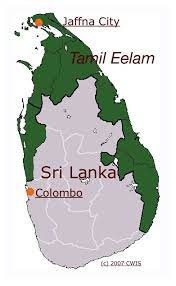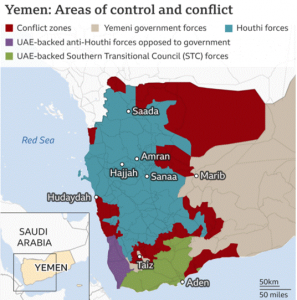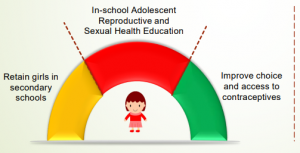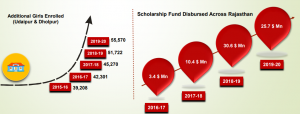THE INTERNATIONAL RELATIONS
1. SRI LANKA TO SET UP SPECIAL NORTH-EAST FUND
THE CONTEXT: The Sri Lankan government will set up a ‘North-East Development Fund’ to increase investments in the war-affected areas, while probing cases of enforced disappearances and land grabs that remain chief concerns of the Tamil people 13 years after the war ended.
THE EXPLANATION:
- It was first meeting with the country’s Tamil political leadership since his election to office in November 2019.

- The TNA has been demanding that the government deliver the long-pending political solution to Sri Lanka’s national question, through a new constitutional settlement.
- The President agreed to focus on four key areas, including
- possibly releasing long-term detainees under the country’s draconian Prevention of Terrorism Act — which the government recently amended but critics want repealed — and suspects held without being charged.
- ending the incessant land grabs in the north and east by different state agencies to allegedly change the demographics of the region.
- inquiring into cases of enforced disappearances.
- establishing a special development fund for the north and east.
- The initiative to set up a development fund exclusively for the war-affected areas comes nearly three years after his election, amid widespread joblessness, indebtedness, and poverty in the region that the pandemic and Sri Lanka’s current economic crisis have only aggravated.
2. INDIA, U.K. END ROUND TWO TALKS ON FTA
THE CONTEXT: India and the United Kingdom concluded a second round of negotiations towards a bilateral Free Trade Agreement (FTA) in London, with a draft treaty text discussed across most chapters that will make up the pact.
THE EXPLANATION:
- The FTA is expected to facilitate the target of doubling bilateral trade between India and the United Kingdom by 2030, set by the Prime Ministers of both nations.
- According to the agreements, the Mutual Recognition Agreements (MRAs) on Pharma could provide additional market access. There is also great potential for increasing exports in service sectors like IT/ITES, Nursing, education, healthcare, including AYUSH and audio-visual services. India would also be seeking special arrangements for the movement of its people.
- India-UK FTA will also contribute to integrating value chains and help augment our mutual efforts to strengthen the resilience of supply chains. Reminding that the leaders of both nations had envisioned launching the FTA Negotiations in early 2022.
What is a Free Trade Agreement (FTA)?
A free trade agreement is a pact between two or more nations to reduce barriers to imports and exports among them. Under a free trade policy, goods and services can be bought and sold across international borders with little or no government tariffs, quotas, subsidies, or prohibitions to inhibit their exchange.
Key features of Free Trade Agreements (FTAs):
- The member nations of FTAs explicitly identify the duties and tariffs that are to be imposed on member countries when it comes to imports and exports.
- FTAs typically cover trades in (a) merchandise — such as agricultural or industrial products (b) services — such as banking, construction, trading and so forth (c) intellectual property rights (IPRs), (d) investment (e) government procurement (f) competition policy and so on.
- FTAs additionally, for the most part, provide a criterion called the ‘Rules of Origin (RoO)’, required for the determination of the product’s country of origin for the imposition of the preferential tariff on international trade.
- FTAs act as an exception to the Most Favored Nation principle adopted by WTO (World Trade Organization).
Value Addition:
India-UK bilateral trade
- Bilateral trade between India and UK stood at 18.3 billion in the year 2020. It was lesser than the trade of 3 billion pounds in 2019. India and UK have also launched a new Enhanced Trade Partnership. It opened ways for future Free Trade Agreements.
- Currently, India is the largest market with which the UK has committed to negotiating any trade deal. India is the second-largest investor in the UK economy.
- About 842 Indian companies in the UK, are employing more than 110,000 people. The combined revenue of Indian companies has increased by 87% in the last five years.
3. THE HOUTHI ATTACK ON THE UNITED ARAB EMIRATES
THE CONTEXT: A Yemeni rebel attack on a Saudi oil plant set off a huge fire near Jeddah’s Formula One circuit, part of a wave of assaults on Aramco facilities.
THE EXPLANATION:
- The Shia Houthi rebels of Yemen, who have been controlling the northern parts of the country, including the capital Sana’a, for almost seven years, have claimed responsibility for the attack.
Who are the Houthis?
Founded in the 1990s by Hussein Badreddin al-Houthi, a member of Yemen’s Shia majority, the Houthi movement has a pretty straightforward slogan or sarkha: “God is great, death to America, death to Israel, the curse on the Jews, victory to Islam.” After Yemeni soldiers killed Hussein in 2004, his brother Abdul Malik took over.
How did Saudi Arabia get involved?
The rise of the Houth is sent alarm bells ringing across Sunni Arab states, particularly Saudi Arabia. A Saudi-led coalition — backed by the US, UK and France — then launched an air campaign in Yemen, with the aim of defeating the rebel group.
THE ECONOMIC DEVELOPMENTS
4. RBI SETS GEO-TAGGING RULES FOR PAYMENT TOUCH POINTS
THE CONTEXT: The Reserve Bank of India (RBI) released a framework for geo-tagging of payment system touch points, issuing instructions to bank and non-bank payment system operators to maintain and submit to it the geographical locations of their touch points on a regular basis.
THE EXPLANATION:
According to the central bank, this framework is intended to ensure that there is a robust payment acceptance infrastructure with multiple types of touch points across India, available and accessible at all times.
According to RBI, the banks and non-bank payment system operators need to capture and maintain geographical coordinates for all payment touch points.
Both banks and non-banks need to maintain a registry with accurate location of all payment touch points across the country that should include merchant-related information and payment acceptance infrastructure details.
Besides, banks and non-banks need to report information on payment touch points to the RBI through the Centralised Information Management System (CIMS) of RBI, the framework said.
How does it work?
- In a geo-tagging infrastructure, the geographical coordinates (latitude and longitude) of payment touch points deployed by merchants to receive payments from their customers are captured. According to the RBI, geo-tagging has several benefits including providing insights on regional penetration of digital payments, monitoring infrastructure density across different locations, identifying scope for deploying additional payment touch points, facilitating focused digital literacy programmes.
- The central bank had focussed on the setting up of Payments Infrastructure Development Fund (PIDF) to encourage deployment of acceptance infrastructure, and creating additional touch points is a step in this direction.
5. ‘GUJARAT TOPS AGAIN IN EXPORT PREPAREDNESS INDEX’
THE CONTEXT: Gujarat has been named India’s top State in terms of export preparedness for the second year in a row as per an index released by the NITI Aayog.
THE EXPLANATION:
Maharashtra, Karnataka, Tamil Nadu were ranked second, third and fourth in the index, as coastal States with higher industrial activity and access to seaports account for a majority of India’s exports.
| Framework:
The 4 pillars and the rationale behind their selection is given below:
|
Challenges:
The index identifies three major challenges to India’s export promotion efforts.
- “These are intra- and inter-regional differences in export infrastructure.
- Weak trade support and growth orientation across States and
- Lack of R&D infrastructure to promote complex and unique exports,”
EPI 2021 – Key Goals
The EPI’s primary goal is to instill competition among all Indian states (‘Coastal’, ‘Landlocked’, ‘Himalayan’, and ‘UTs/City-States’) to bring about favourable export-promotion policies, ease the regulatory framework to prompt sub national export promotion, create the necessary infrastructure for exports, and assist in identifying strategic recommendations for improving export competitiveness. It promotes competitive federalism and a fair contest among States/UTs.
THE GOVERNMENT SCHEMES/INITIATIVES IN NEWS
6. ‘PROJECT UDAAN’ GIVES GIRLS WINGS TO A BETTER FUTURE IN RURAL RAJASTHAN
THE CONTEXT: The Udaan project, launched by the Rajasthan government in collaboration with a development consulting group ‘IPE Global’, has made attempts to keep girls in schools through their enrollment at the secondary level while ensuring that the eligible ones among them get their scholarships. While generating awareness about scholarship schemes, the programme has also mobilised rural communities to support girls’ education and facilitate their attendance in school without a break.
THE EXPLANATION:
- Project Udaan seeks to reduce adolescent pregnancies in Rajasthan by leveraging existing government platforms and programmes across the Health and Education Departments, for scale up and sustainability.
- It adopts a multi-sectoral approach to prevent adolescent pregnancy, layering interventions beyond sexual health, to fundamentally change the way adolescent programming is carried on.

- Udaan attempts to keep girls in school through their enrollment (school-going and dropout girls) at secondary school level while ensuring that the eligible girls receive their scholarship through collective efforts.
- School and community-level interventions have been designed to increase girls’ enrollment at secondary level school by generating wide public awareness on the scholarship schemes and mobilising communities to support girls’ education and facilitate their going back to school. It works towards strengthening scholarship delivery systems (IT enabled) and builds capacities of government functionaries for effective state-wide scale up to ensure sustainability and stability.
- It is an integrated intervention which seeks to prevent adolescent pregnancies in Rajasthan by leveraging existing government programmes and platforms for realizing girl’s potential and reducing the number of babies born low birth weight from teenager mothers.

THE PRELIMS PRACTICE QUESTIONS
QUESTIONS OF THE DAY 26th MARCH 2022
Q1. Which of the following statement is incorrect about Organization of Islamic Countries (OIC)?
a) It was established in 1969.
b) It has total 57 member countries.
c) Its headquarter is located in Abu Dhabi, UAE.
d) India is not a member of OIC.
ANSWER FOR 25TH MARCH 2022
Answer: C
Explanation:
Statement 1 is correct: National Initiative for Proficiency in Reading with Understanding and Numeracy (NIPUN Bharat) seeks to create an enabling environment to ensure universal acquisition of foundational literacy and numeracy, so that every child achieves the desired learning competencies in reading, writing and numeracy by the end of Grade 3, by 2026-27.
Statement 2 is incorrect: Although the National Education Policy had included a 2025 deadline to achieve the goal, the Centre has pushed back the target date to 2026-27, given that COVID-19 has already disrupted two academic years.
Spread the Word


